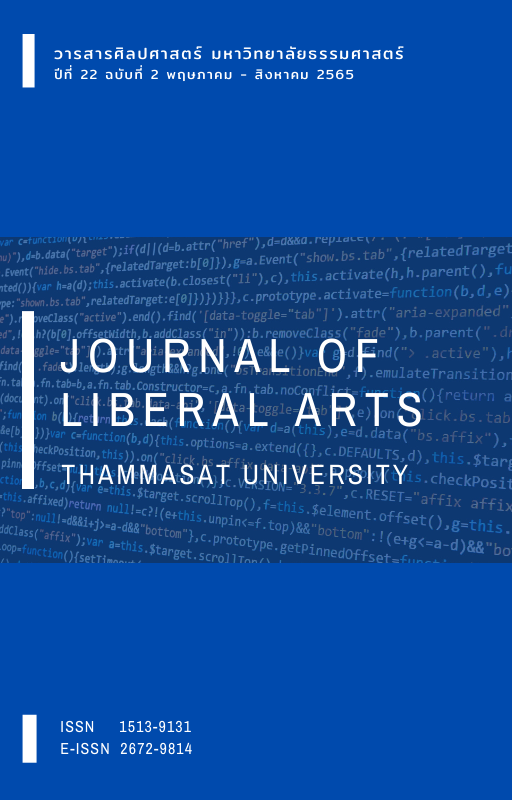ความเป็นอื่น การนิยามตนเอง และการประกอบสร้างอัตลักษณ์ การท่องเที่ยวจากส่วนกลาง: กรณีศึกษาเมืองถูหลู่ฟาน เขตปกครองตนเองซินเจียงอุยกูร์
Main Article Content
บทคัดย่อ
วาทกรรมการพัฒนารูปแบบหนึ่งซึ่งรัฐบาลจีนกำหนดขึ้นมาในเขตปกครองตนเองซินเจียงอุยกูร์ คือ “การท่องเที่ยว” โดยอาศัยอัตลักษณ์เป็นเครื่องยึดโยงระหว่างความเป็นอื่นกับความเป็นจีนอย่างแยบคาย บทความนี้เจาะจงศึกษาไปที่เมืองถูหลู่ฟาน ศูนย์กลางการท่องเที่ยวเชิงวัฒนธรรมของซินเจียง จากการลงพื้นที่ภาคสนามร่วมกับการวิเคราะห์เอกสาร ค้นพบ 3 ประเด็นที่น่าสนใจ ได้แก่ (1) การขายความเป็นอื่น พบว่านักท่องเที่ยวส่วนใหญ่ซึ่งเป็นชาวฮั่น มักจะได้รับการกระตุ้นจากการประชาสัมพันธ์การท่องเที่ยวที่มุ่งเน้นการขายความแตกต่างทางวัฒนธรรม อาทิ วิถีชีวิตของชาวอุยกูร์ สาวงามแห่งโหลวหลาน รวมไปถึงวัฒนธรรมอาหารแบบมุสลิม (2) การนิยามตนเอง พบว่าชาวอุยกูร์กำหนดตนเองเป็น “ส่วนหนึ่งของจีน แต่ไม่ใช่จีน” ผ่านบริบทมุสลิมจีนและอำนาจทางวัฒนธรรมว่าด้วยความเป็นพื้นเมือง และ (3) การประกอบสร้างอัตลักษณ์ พบว่าในระดับท้องถิ่น มีกระบวนการสร้างตัวตนบนพื้นฐานความเป็นอื่นโดยเจตนา เพื่อประโยชน์ในอุตสาหกรรมการท่องเที่ยว ทว่าในระดับชาติพบการประกอบสร้างอัตลักษณ์ที่เกิดจากวาทกรรมจากส่วนกลาง เช่น กรณีรัฐบาลจีนมีความพยายามที่จะเชื่อมโยงความเป็นฮั่นกับถูหลู่ฟาน โดยการอรรถาธิบายประวัติศาสตร์ร่วมระหว่างฮั่นกับอุยกูร์ เช่น เส้นทางสายไหม และวรรณกรรมไซอิ๋ว เพื่อใช้เป็นเครื่องมือผสานข้ามวัฒนธรรม ที่ให้การท่องเที่ยวเป็นส่วนหนึ่งในการสร้างความชอบธรรมของชาวฮั่น และการเชิดชูประวัติศาสตร์ซินเจียงในฐานะส่วนหนึ่งของประวัติศาสตร์จีน
Downloads
Article Details

อนุญาตภายใต้เงื่อนไข Creative Commons Attribution-NonCommercial-NoDerivatives 4.0 International License.
เอกสารอ้างอิง
Amnesty International. (1999). Gross Violations of Human Rights in the Xinjiang Uyghur Autonomous Region. Amnesty International.
Aree, S. (2019, November 28). Urghur’s Problem Background through the Chinese Studies Academician Vision. The Standard. https://thestandard.co/uyghurs-problem/
Askhar, A. (2020, June 13). Xinjiang Unveils Events to Mark National Cultural Day. China Daily. https://www.chinadaily.com.cn/a/202006/13/WS5ee47aaaa310834817252d19.html
Berlie, J. A. (2004). Islam in China: Hui and Uyghurs between Modernization and Sinicization. White Lotus Press.
Calla, W. (2004). The Economy of Xinjiang. M.E. Sharpe.
China Internet Information Center. (2020). Xinjiang Tourism Information. China Internet Information Center.
Colin, T. (2010). Shadow of Silkroad. Atiken Alexander Associates Limited.
Department of Intellectual Property. (2020). Geographical Indications. Ministry of Commerce.
Dillon, M. (2004). Xinjiang-China’s Muslim Far Northwest. Routledge.
Fairclough, N. (1999). Discourse and Social Change. Polity Press.
Gardner, B. (2004). Autonomy in Xinjiang: Han Nationalist Imperatives and Urghur Discontent. East-West Center.
International Culture Association of Xinjiang Uyghur Autonomous Region. (2008). Xinjiang. Xinjiang Fine Arts and Photography Publishing House.
Kabinsing, C. (2018). The Silk Road. Kledthai.
Kaewthep, K. (2010). Political Economic Theories with Communication Studies. Phappim.
Kondhi, K. (2017, June 29). Adventure in Xinjiang: Legend of Silk Road. Siamrat. https://siamrath.co.th/n/18542
Li, Xiao. (2017). Environmental Reconstruction of Tuyoq in the Fifth Century and Its Bearing on Buddhism in Turpan, Xinjiang. University of Vienna.
Lilion, C. H. (1993). Xinjiang, Central Asia and the Implications for China’s Policy in the Islamic World. China Quarterly, 20, 111-129.
Matichon. (2019, May 11). Domestic Tourism in China: 40 Million Tourist along the 5,000 Kilometers of the Ancient Silk Road, Xinjiang Uyghur. Matichon. https://www.matichonweekly.com/special-report/article_189153
Putnark, V. (2017, February 1). Xenophobia. The Matter. https://thematter.co/social/ how-fear-of-other-unreasonable/17437
Thandee, D. (1977). Anthropology and Social. Ramkhamhaeng University.
Theeravit, K. (1997). China’s Foreign Policy. Chinese Studies Center, Institute of Asian Studies, Chulalongkorn University.
Uyghur Human Rights Project. (2006). Uyghurs and Human Rights: The 50th Anniversary of the Xinjiang Uyghur Autonomous Region. Uyghur Human Rights Project.
Winters, Clyde-Ahmad. (1979). Mao or Muhammad: Islam in the People’s Republic of China. Asian Research Services.
Xinhuathai. (2020, July 3). New Railroad in Xinjiang. Xinhuathai. https://www.xinhuathai.com/china/119624_20200703
Xinjiang Uyghur Autonomous Region. (2004). Xinjiang Tourism. Hong Kong China Tourism Press.
Xinjiang Uyghur Autonomous Region Bureau of Statistics. (1996). Xinjiang Statistical Yearbook. China Statistic Press.
Yaun, Qingli. (1990). Population Changes in Xinjiang Uyghur Autonomous Region (1949-1984). Routledge.


